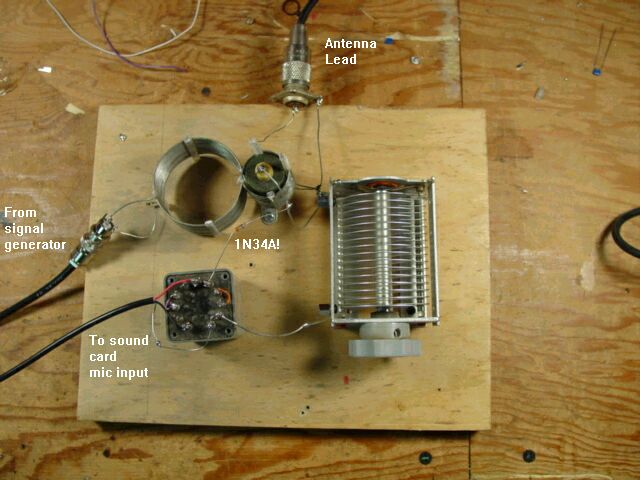...Receiver here is a 1N34A...

It had been a long winter, and the snow was still falling on March 12. Cabin fever will drive you to do strange things, such as construct
the receiver shown above. Warren Ziegler, WD2XGJ, was sending CW on 137.9 kHz, and I had just measured signal level as -54 dBm from my big
transmit loop. As I was musing about how strong that was, it occurred to me that he could be received with a much simpler receiver. About an
hour later, Warren's CW was nicely audible on my computer speaker.
While the regenerative receiver has advantages for sensitivity, direct conversion receivers were sometimes used to copy non-spark signals years
ago. A local oscillator was inductively coupled into a crystal receiver, with the beat frequency audible in the headphones. Early on, oscillators
such as high speed tone wheels or buzzers coupled into tuned circuits were used. As tube oscillators became available, they took over, as
they were easier to construct, and better suited to frequencies over 50 kHz or so.
The receiver above uses a tuned circuit consisting of a transmit RF choke and the variable capacitor. My big loop antenna is inductively coupled
with some coil stock slipped over the choke. Another piece of coil stock is connected to an old URM-25D signal generator, and coupled to the input
circuit. A 1N34A germanium diode feeds the plate winding on a UTC A-26 output transformer, and the line side runs to the microphone input
on my computer's sound card. The generator is set for a beat note against WD2XGJ, and that's it!
Here's what it sounded like (176 kB WAV file). Loran-C is clearly audible in the background.
It's a good thing that CFH was not running on 137 kHz. Actually, if it had been, I wouldn't have needed the signal generator!
And just to prove that point, CFH started up on Sunday around 2230 UTC. So I removed the coupling coil to the
signal generator, and ran the receiver as a simple crystal set. With CFH on 137.0, and XGJ on 137.9, there is an audible
beat, modulated by the data on CFH.
Here's the results (151 kB WAV file).
Back to Home
